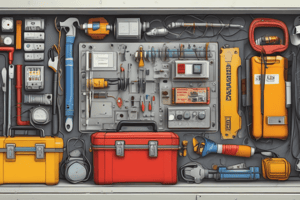Podcast
Questions and Answers
What was a primary failure that led to the arc flash incident during fuse re-installation?
What was a primary failure that led to the arc flash incident during fuse re-installation?
- A PTW was in place to communicate and coordinate activities but was ignored.
- The electrician did not verify that the power to the drive cabinet was isolated before starting work. (correct)
- The vessel's SOP considered isolations as long-term, providing sufficient protection.
- The electrician used an incorrectly rated fuse insertion tool, which led to tool failure.
In the incident involving the fall from height, what critical factor contributed to the LTI?
In the incident involving the fall from height, what critical factor contributed to the LTI?
- There was a failure in situational awareness combined with inadequate communication between team members. (correct)
- The bridge gantry gratings were clearly marked, but the markings were ignored.
- The work was occurring during routine operations, so additional safety measures were deemed unnecessary.
- The injured party deliberately ignored safety protocols to expedite the task.
Why was the site supervisor found responsible in the conveyor belt incident where a worker's arm became entangled?
Why was the site supervisor found responsible in the conveyor belt incident where a worker's arm became entangled?
- The company had no policies or procedures regarding Permit to Work or isolation.
- The site supervisor became distracted and failed to complete the required Permit to Work and isolation procedures. (correct)
- The conveyor belt was known to be faulty, but the supervisor ordered the worker to proceed anyway.
- The site supervisor was properly completing the Permit to Work, but the worker ignored the instructions.
In the context of the fractured finger incident, what does 'Safety by design' refer to?
In the context of the fractured finger incident, what does 'Safety by design' refer to?
What critical failure was identified in the UK HSE report regarding the uncontrolled release of LPG at a refinery?
What critical failure was identified in the UK HSE report regarding the uncontrolled release of LPG at a refinery?
Flashcards
What is a Permit to Work (PTW)?
What is a Permit to Work (PTW)?
A formal process used to control, communicate, and coordinate potentially hazardous activities.
What is the golden rule?
What is the golden rule?
Before starting any work, confirm that the system you will work on is isolated before you start work.
What are SIMOPS? (Simultaneous Operations)
What are SIMOPS? (Simultaneous Operations)
Combined operations occurring simultaneously that introduce additional hazards. Proper planning is crucial.
What is 'Safety by Design'?
What is 'Safety by Design'?
Signup and view all the flashcards
What is layers of protection?
What is layers of protection?
Signup and view all the flashcards
Study Notes
Permit to Work and Isolation Incident
- An electrician installed fuses on a live 930V DC electrical system
- Under deck carousels were mechanically and electrically isolated as a maintenance precaution
- The electrical isolation involved removing fuses for the carousel drive unit
- Several other important vessel systems were powered by the same drive cabinet
- The vessel was in port and other vessel systems were not powered when fuses were initially removed
- The electrician isolated the power to the entire drive cabinet by isolating breakers and removing fuses, then left fuses at the bottom of the cabinet
- Tags were not applied, and the cabinet was not locked
- Another electrician re-installed fuses, believing the cabinet's power was isolated
- The second electrician opened the cabinet, removed the protective mesh, and installed fuses using a 1000V-rated fuse insertion tool
- An arc flash occurred, and the fuse blew during the second fuse installation, but the electrician was not injured
Factors that Contributed to the Incident
- No Permit To Work (PTW) was in place to control, communicate, or coordinate activities
- The work team didn't understand or apply the necessary level of control for electrical work and isolations
- Isolations were incorrectly applied
- Vessel Standard Operating Procedures (SOP) for work on equipment powered by the drive cabinet did not consider long-term isolations to protect multiple workers
- Procedures were not followed including the electrician not locking and tagging the cabinet when removing fuses
- Electrical cabinet security was not in accordance with company procedures
- Additional work team requirements regarding isolations were discussed in the Toolbox Talk (TBT) but not implemented
- The electrician re-installing fuses failed to verify the drive cabinet's power was isolated
Recommended Actions
- Review procedures, work instructions, and task risk assessments for Permit to Work and electrical isolations
- Review Toolbox Talks to ensure they cover all aspects of work, including PTW and isolations
- Verify the system you are working on is isolated BEFORE starting work
- Adhere to workplace instructions and warning signs, and ask questions if unsure
Fall from Height Incident
- Two teams of four crew members maintained the vessel superstructure
- One team worked on the monkey island
- The other team worked on the bridge level gantry, removing gratings and working on the steel frame
- The team from the monkey island came down to the bridge level, and one member removed his safety harness
- The crew member spotted a paint drip and decided to check the bridge before break
- Restricted space forced the crew member to work backwards without looking for obstacles
- Although aware of another team working on gratings, he didn't confirm their location
- The crew member stepped backwards and fell 3m through the opening from the lifted grating to the boat deck
- The incident was considered an LTI (Lost Time Injury)
Factors that Contributed to the Fall
- Work and Permit to Work Systems weren't correctly implemented
- Lack of situational awareness, risk perception, awareness of Simultaneous Operations (SIMOPS), and poor communication among deck personnel
- No barriers or signage marked the area of the incident
- Removal of bridge gantry gratings introduced a fall hazard
Recommended Actions
- Conduct more effective toolbox talks and pre-task risk assessments
- During scope of work planning, identify combined operations and additional hazards introduced by SIMOPS and assess if SIMOPS can be avoided
- Assess risk associated with the SIMOPS
- Determine if planned control measures are adequate, and update if not
- Keep a record of incidents
Conveyor Belt Injury Incident
- A supervisor was sentenced for safety breaches after a worker got his arm entangled in a conveyor belt
- The worker was repairing a damaged conveyor belt
- The conveyor line started, and his arm got entangled, causing muscle and tissue damage
- The site supervisor was responsible for completing a Permit to Work and isolating the line but got distracted
- The Permit to Work and isolation were not completed, causing the conveyor belt to restart
Inspector Findings
- The site supervisor did not implement company policy for Permits to Work and isolation and the injury could have been avoided with correct control measures
Metal Plate Handling Incident
- A crew member suffered a pinch injury to his finger while working on deck
- The injury resulted in a distal fracture to the finger tip and a laceration requiring sutures
- Heavy weather damaged welded plates on deck
- While manually handling the plate with another crew member, the injured person's finger was trapped between the plate and frame
Factors that Contributed to the Incident
- The plate wasn't designed for safe manual handling
- The plate installation had a permanent risk of finger entrapment
- Risk assessments and toolbox talks were generic rather than task-specific
- The JSA only covered hot work and not manual handling
Lessons Learned
- Apply safety by design, modifying plates with temporary handles to keep fingers away from pinch points
- Use magnetic lifting handles
- Tailor risk assessments or use a dynamic risk assessment/toolbox talk for a full task review
- Assess if tasks are slow, uncomfortable, or inconvenient and use the toolbox talk or JSA to define and reduce risks
Liquid Petroleum Gas (LPG) Leak Incident
- The operator of the UK's largest oil refinery was fined for health and safety breaches
- A worker discovered a liquid petroleum gas (LPG) leak while cycling home
- Around 15 tonnes of LPG released through a valve near a roadway used by LPG road tankers at a refinery in Fawley, Hants, UK
- The leak went undetected for about four hours without detection by on-site staff
- It took another hour for on-site emergency personnel to identify and stop the leak
Factors that Contributed to the Leak
- A Health and Safety Executive (HSE) investigation found that LPG was put through the pipe work at too high a pressure
- No process existed to detect flow discrepancies in the pipe
- The company failed to take necessary measures to prevent a major incident
Inspector Comments
- Measures to prevent incidents should be proportionate to risks
- Companies handling large quantities of hazardous substances must have layers of protection
- The incident occurred because multiple layers of protection failed or were not in place, resulting in a major leak
- The prosecution highlights the importance of maintaining layers of protection
Studying That Suits You
Use AI to generate personalized quizzes and flashcards to suit your learning preferences.




